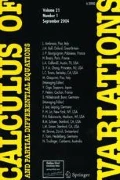Abstract
We study the following coupled Schrödinger system which has appeared as several models from mathematical physics:
Here, N = 2, 3, and λ 1, λ 2, μ 1, μ 2 are all positive constants. In [Ambrosetti and Colorado in C R Acad Sci Paris Ser I 342:453–438, 2006], Ambrosetti and Colorado showed that, there exists β 0 > 0 such that this system has a nontrivial positive radially symmetric solution for any \({\beta \in (0, \beta_0)}\). Later in [Ikoma and Tanaka in Calc Var 40:449–480, 2011], Ikoma and Tanaka showed that solutions obtained by Ambrosetti and Colorado are indeed least energy solutions for any \({\beta \in (0, {\rm min}\{\beta_0, \sqrt{\mu_1\mu_2}\})}\) . Here, in case λ 1 = λ 2 and μ 1 ≠ μ 2, we prove the uniqueness of the positive solutions for min{μ 1, μ 2} − β > 0 sufficiently small. In case λ 1 ≠ λ 2 and (λ 2 − λ 1)(μ 2 − μ 1) ≤ 0, we prove that \({\beta_0 < \sqrt{\mu_1\mu_2}}\) and β 0 is optimal, in the sense that this system has no nontrivial least energy solutions for \({\beta \in (\beta_0, \sqrt{\mu_1\mu_2})}\) . Moreover, there exists δ > 0 such that this system has no nontrivial nonnegative solutions for any \({\beta \in ({\rm min}\{\mu_1, \mu_2\} - \delta,\, \max\{\mu_1, \mu_2\} + \delta)}\) . This answers an open question of [Sirakov in Commun Math Phys 271:199–221, 2007] partially, and improves a result of [Sirakov in Commun Math Phys 271:199–221, 2007]. The asymptotic behavior of the least energy solutions is also studied as \({\beta \nearrow \beta_0}\) .
Similar content being viewed by others
References
Akhmediev N., Ankiewicz A.: Partially coherent solitons on a finite background. Phys. Rev. Lett. 82, 2661–2664 (1999)
Ambrosetti A., Colorado E.: Bound and ground states of coupled nonlinear Schrödinger equations. C. R. Math. Acad. Sci. Paris Ser. I 342, 453–458 (2006)
Ambrosetti A., Colorado E.: Standing waves of some coupled nonlinear Schrödinger equations. J. Lond. Math. Soc. 75, 67–82 (2007)
Bartsch T., Wang Z.-Q.: Note on ground states of nonlinear Schrödinger systems. J. Partial Differ. Equ. 19, 200–207 (2006)
Bartsch T., Willem M.: Infinitely many radial solutions of a semilinear elliptic problem on \({\mathbb{R}^N}\) . Arch. Ration. Mech. Anal. 124, 261–276 (1993)
Bartsch T., Wang Z.-Q., Wei J.: Bound states for a coupled Schrödinger system. J. Fixed Point Theory Appl. 2, 353–367 (2007)
Bartsch T., Dancer N., Wang Z.-Q.: A Liouville theorem, a priori bounds, and bifurcating branches of positive solutions for a nonlinear elliptic system. Calc. Var. Partial Differ. Equ. 37, 345–361 (2010)
Busca J., Sirakov B.: Symmetry results for semilinear elliptic systems in the whole space. J. Differ. Equ. 163, 41–56 (2000)
Crandall M., Rabinowitz P.: Bifurcation form simple eigenvalues. J. Funct. Anal. 8, 321–340 (1971)
Crandall M., Rabinowitz P.: Bifurcation, perturbation of simple eigenvalues and linearied stability. Arch. Ration. Mech. Anal. 52, 161–180 (1973)
Chen Z., Zou W.: Positive least energy solutions and phase separation for coupled Schrödinger equations with critical exponent. Arch. Ration. Mech. Anal. 205, 515–551 (2012)
Conti M., Teraccini S., Verzini G.: Nehari’s problem and competing species systems. Ann. Inst. H. Poincaré Anal. Non Linéaire 19, 871–888 (2002)
Conti M., Teraccini S., Verzini G.: An optimal partition problem related to nonlinear eigenvalues. J. Funct. Anal. 198, 160–196 (2003)
Dancer E., Wei J.: Spike solutions in coupled nonlinear Schrödinger equations with attractive interaciton. Trans. Am. Math. Soc. 361, 1189–1208 (2009)
de Figueiredo D., Lopes O.: Solitary waves for some nonlinear Schrödinger systems. Ann. Inst. H. Poincaré Anal. Non Linéaire 25, 149–161 (2008)
Esry B., Greene C., Burke J., Bohn J.: Hartree-Fock theory for double condesates. Phys. Rev. Lett. 78, 3594–3597 (1997)
Gidas B., Spruck J.: Global and local behavior of positive solutions of nonlinear elliptic equations. Commun. Pure Appl. Math. 35, 525–598 (1981)
Ikoma N., Tanaka K.: A local mountain pass type result for a system of nonlinear Schrödinger equations. Calc. Var. Partial Differ. Equ. 40, 449–480 (2011)
Lin T., Wei J.: Ground state of N coupled nonlinear Schrödinger equations in \({\mathbb{R}^N}\) , n ≤ 3. Commun. Math. Phys. 255, 629–653 (2005)
Liu Z., Wang Z.-Q.: Ground states and bound states of a nonlinear Schrödinger system. Adv. Nonlinear Stud. 10, 175–193 (2010)
Maia L., Montefusco E., Pellacci B.: Positive solutions for a weakly coupled nonlinear Schrödinger systems. J. Differ. Equ. 229, 743–767 (2006)
Palais R.: The principle of symmetric criticality. Commum. Math. Phys. 69, 19–30 (1979)
Sirakov B.: Least energy solitary waves for a system of nonlinear Schrödinger equations in \({\mathbb{R}^N}\) . Commun. Math. Phys. 271, 199–221 (2007)
Struwe M.: Variational Methods—Applications to Nonlinear Partial Differential Equations and Hamiltonian Systems. Springer, Berlin (1996)
Wei J., Yao W.: Uniqueness of positive solutions to some coupled nonlinear Schrödinger equations. Commun. Pure. Appl. Anal. 11, 1003–1011 (2012)
Author information
Authors and Affiliations
Corresponding author
Additional information
Communicated by P.Rabinowitz.
Rights and permissions
About this article
Cite this article
Chen, Z., Zou, W. An optimal constant for the existence of least energy solutions of a coupled Schrödinger system. Calc. Var. 48, 695–711 (2013). https://doi.org/10.1007/s00526-012-0568-2
Received:
Accepted:
Published:
Issue Date:
DOI: https://doi.org/10.1007/s00526-012-0568-2


